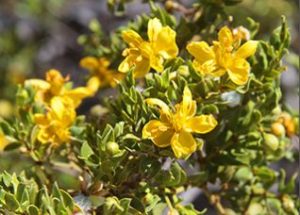
Scientific name: Larrea divaricata
Synonymn: Larrea Tridentata
Family: Zygophyllaceae
Other names: Creosote bush, Grease bush, Chaparro, Chaparral, Greasewood, Gobonadora, Gobernadora, Dwarf evergreen oak
Medicinal Parts Used
Leaves (primarily), flowers.
constituents
The leaves and stems of creosote bush contain a generous supply of gums and resins, protein, partially characterised esters, acids, alcohol, a small amount of mixture of sterols, sucrose, and a very small amount of volatile oils. No alkaloids were detected and it is nontoxic.
Action
Antibiotic, powerful blood cleanser, bactericidal, anti-inflammatory, alterative, respiratory and urinary antiseptic, anti-oxidant, anti-psoriasis, anti-arthritic. Contains NDGA a powerful parasiticide. Anti-tumour, anti-microbial. Strong bitter, enzyme inhibitor. All body cells feel its influence.
Uses
Regarded as a ‘cure-all’ by the Arizona Indians. Used for rheumatism, arthritis, skin disorders, bursitis, lumbago, healing of external wounds, delayed menses, indigestion, kidney disorders, piles, tetanus and itching. Early American agent for sexually transmitted diseases. History of use in skin malignancy and skin cancer. Chronic chest complaints (tea), gangrene, to strengthen eyes weakened from diabetes, cataract and to counteract metal poisoning.
Caution
Pregnancy and lactation In vitro utero activity has been documented for chaparral. In view of the concerns regarding toxicity, chaparral should not be ingested during pregnancy or lactation.
“Larrea is strong and could possibly cause some health problems taken in large doses over a long period of time.” (Plant Medicine Notes)
Note: The sale of Chaparral has been banned in the United States of America and the United Kingdom as a result of reported cases of human toxicity.
Preparations and Dosage
Best uses reported from tea or tablets.
Tea: daily bitter health beverage; half a teaspoon to each cup boiling water; infuse 15 minutes. Half to 1 cup, thrice daily. (Bartram)
Tablets/capsules: one 150mg thrice daily. (Bartram)
alt. Capsules, #00, 2-4 a day.
Ointment: 1oz powdered herb to 16oz carrier oil. Steep one hour in an oven 300-350 degrees F. Strain through sieve; pour into jar. This may also be done via cold infusion.
Tincture: Leafing branches [1:5, 75% alcohol], 20-60 drops.
Strong decoction for topical use.
Topical application of Larrea (chaparral) leaf and flower infused into castor oil over the pelvic area once or twice a day as an anti-inflammatory therapy.
Combinations
Combines with Sarsaparilla (equal parts) for venereal infections and chancre. (Dr J.M. Bigelow)
Chaparral and Herpes
Anti-VZV herbs are based on historical treatments and extrapolation from its anti-herpes simplex activity – Chaparall (Larrea tridentata) is one of the herbs found useful in this regard – leaf, flower, and seed.
Shingles
Larrea tridentata (chaparral) flowering tops – for Shingles and Postherpetic Neuralgia.
NSAID Drug protection
Chaparral leaves (Larrea tridentata) − Protects against NSAID-induced ulcers.
Source:
Herb Formulas for Clinic and Home, Michael Moore
Bartram’s Encyclopedia of Herbal Medicine, Thomas Bartram
A Handbook of Native American Herbs, Alma Hutchens
Natural remedies Encyclopedia
Plant Medicine Notes-Chaparral (Larrea Tridentata)
The information provided here are for educational purposes only, and is meant to help users better understand health concerns. This information should not be interpreted as specific medical advice. Users should consult with a qualified healthcare provider for specific questions regarding therapies, diagnosis and/or health conditions, prior to making therapeutic decisions.
DISCLAIMER: THIS WEBSITE DOES NOT PROVIDE MEDICAL ADVICE
The information, including but not limited to, text, graphics, images and other material contained on this website are for informational purposes only. The purpose of this website is to promote broad consumer understanding and knowledge of various health topics. It is not intended to be a substitute for professional medical advice, diagnosis or treatment. Always seek the advice of your physician or other qualified health care provider with any questions you may have regarding a medical condition or treatment and before undertaking a new health care regimen, and never disregard professional medical advice or delay in seeking it because of something you have read on this website.